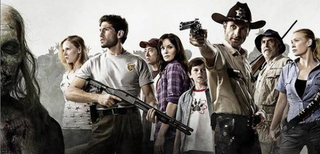The Walking Dead began as a comic book series in October 2003. The series is written by Robert Kirkman (who at the time was best known for his work on Invincible and Battle Pope) and illustrated by Charlie Adlard, who replaced artist Tony Moore after the first story arc. Kirkman's still writing the series. Over time, the comic became a best-seller without almost no fanfare, hence the massive eBay dinero.
In 2009, AMC and director Frank Darabont (The Shawshank Redemption) began circling the project, and hence the TV series was created. Kirkman's admitted that he's envision the series as a TV show, and that a film wouldn't do the comic's neverending zombie narrative justice. Kirkman may just get his wish.
Interview with Robert Kirkman
What's The Walking Dead's claim to fame?
It's easily the most popular zombie comic ever written. Kirkman's described the series as an infinite survival horror epic. Characters frequently migrate from location to location, scouring abandoned neighborhoods for supplies and dying every two issues or so. The zombies are a problem, but so are hunger, exposure, and other desperate humans.
Does the series follow the comic faithfully?
For the most part. It is however taking creative liberties with regards to new survivors and the zombies' abilities. Darabont, who directed the premiere and creatively supervised the first season, has also mentioned that the show will add its own embellishments.
What causes the zombie uprising in The Walking Dead?
In the comic, it's not entirely clear, and it's kind of a moot point anyway. Kirkman's said that he'll never reveal the origins of the undead uprising. Furthermore, it's just not the series' foremost concern. The main characters aren't super-sexy undead researchers. They're average schmos with average lives, and — barring one or two seemingly unkillable characters — they die extremely easily. The series is about staying alive (i.e. finding food, ammunition, and shelter; not going insane). We have yet to see whether the TV show will address the zombies' origins.
Who are the main characters?
The comic book takes place in the southern United States (predominantly Georgia) and showcases what feels like a cast of thousands. That's okay though, as characters die with startlingly regularity. Here's the main cast at the beginning of the series. Don't get too attached to any of them:
Rick Grimes is a cop who lives in Cynthiana, Kentucky (artist Tony Moore's hometown) with his wife Lori and son Carl. After a shootout with criminals, Rick is injured and goes into a coma. When he wakes up a few weeks later, the world's gone to pot — the dead have risen, his family is gone, and (friendly) squatters in his neighbor's house have hit him upside the head with a shovel. After Rick awakens from his shovel-induced concussion, the squatters — Morgan Jones and his son Duane — fill Rick in on what's happened to the world. Rick sets off for Atlanta in hopes of finding his family. Indeed, Lori and Carl are living in a survivors' camp outside of the city, but Lori's found comfort in the arms of Rick's former best friend and fellow cop Shane. Other survivors who appear in both the TV show and the comic include Glenn (who's a skilled forager), jocular old man Dale, and sister duo Andrea and Amy.
There are several characters who were introduced in the TV series, so they're unknown quantities. Jacqui, Morales, and T-Dog are all part of Glenn's supply-gathering crew in Atlanta. Merle Dixon is a crazed hillbilly who the survivors handcuff to the roof of a building in Atlanta. He's abandoned at the end of the second episode.
Throughout the comic, the cast expands, contracts, and expands once again. After a while, remembering a characters' names becomes somewhat difficult as there's ridiculous turnover. There's one name you won't forget: Michonne. We're not going to tell you what she's all about...other than the fact that she's quite possibly the most bad-ass character in comic book history.
What kind of zombies star in The Walking Dead?
In the comic book, the zombies are plodding, flesh-hungry, and particularly entranced by loud noises. Brain damage will kill them (decapitation won't). Humans who die from injuries will reanimate as zombies, so it's speculated that the undead outbreak is caused either by a bacteria or virus that lies dormant in living tissue. It's possible to elude the zombies by smearing yourself in zombie offal and imitating their gait.
The zombies have a tendency to move in herds and tend to have problems with stairs. Gunshots will attract undead from miles away, so the characters prefer to dispose of zombies with hammers, axes, and swords. The zombies spread the infection through bites. If an arm or leg is bitten, it's possible to stanch an infection by amputating a limb.
In the television show, the zombies are more mobile (they can run and climb), "remember" their surroundings, and are seen using tools (like bricks). Also, it's unclear whether humans who die from injuries will resurrect — there's a scene in the premiere of corpses outside of a hospital, and it's not specified if these bodies were once zombies or not.
Website reference: http://io9.com/5686018/everything-you-need-to-know-about-the-walking-dead












































